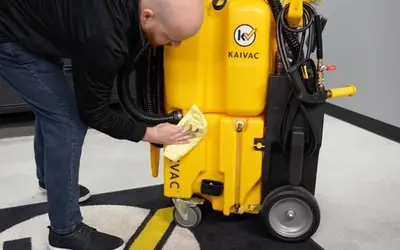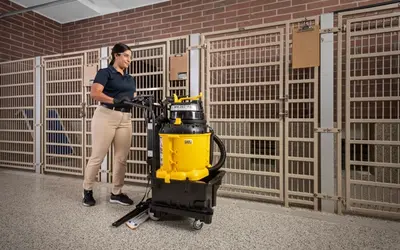How to Clean Up After a Flood

As the frequency and severity of bad weather events increase, knowing how to clean up after a flood can get you back to business sooner. Big, devastating flooding events are on the rise, according to Flood Defenders, a non-profit advocacy group for flood victims. Cleanup costs are mounting too, with billion-dollar events increasing throughout the country.
These incidents can devastate small businesses. Research shows that 40% of affected businesses never reopen after a flood. Those that do manage to open their doors again don’t fare very well, with a whopping 90% failing after two years.
Eye-popping as that is, it doesn’t take a devastating weather event to dampen a business owner’s day. Broken pipes, clogged toilets, or leaking equipment can lead to expensive and dangerous water damage too.
No matter the cause, cleaning up after a flood quickly and safely is the first step to getting back to normal.
Flood Cleanup: Know the Risks
Flooding leaves a variety of dangerous situations in its wake. Assessing the situation is vital for a safe flood cleanup. Dangers to look out for include:
- Electric Shock: Downed power lines are common after a storm. Assume any downed wires are live and avoid them. Have a qualified electrician inspect any electrical equipment that was submerged or received water damage.
- Contaminated Water: Floodwater can be contaminated with all kinds of unpleasant things than cause harm. Human and animal waste, household and industrial chemicals, sharp objects, and even wild animals may be present.
- Mold: It only takes 24 to 48 hours for mold to develop after a flood so cleanup should start as soon as it’s safe. Mild mold exposure can cause a sore throat or eye irritation in otherwise healthy people. It can be more serious for people with asthma or other conditions.
- Slip and Fall: Even smaller flooding incidents can lead to dangerous and costly slip and fall injuries. Burst pipes, failed appliances, massive spills, or even a dropped coffee can be dangerous.
Flood Cleanup: Tools and Techniques
Once an area has been deemed safe to enter, flood cleaning should begin. Start by removing standing water. Pails, pumps, and wet-dry vacuum machines are all valuable tools for this work. (CAUTION: Do not use plugged in equipment if you suspect outlets are compromised. Try battery-powered machines instead.)
Remove any soaked porous materials. Paper, cardboard, textiles, soft furnishings, and carpet may be unsalvageable if they are too wet or contaminated with sewer water. If they can’t be cleaned don’t just put them in the landfill. Check local regulations for proper disposal protocols.
Soaked dry wall material will grow mold. Remove affected areas and the insulation below so the area can dry from the inside out. Clean and disinfect using chlorine bleach. Consider purchasing a moisture meter to better determine how wet walls and finishes actually are. If the affected area is too big, or mold and mildew has already taken hold, it may be best to call mold-remediation professionals.
Flooding from burst pipes, failed equipment, or spills need immediate attention. The mess may be smaller but standing moisture can damage building fixtures, finishes, and furnishings. It can also lead to a slip-and-fall incident.
Remove these spills completely with tools like the No-Touch Cleaning® system from Kaivac. The machine’s powerful, extended-life, wet vacuum removes unwanted moisture and impurities from surfaces. Powered by a Lithium-Ion Power Pack, the No-Touch Cleaning system is safe to use on wet surfaces, plus there’s no cord to accidently trip over.
Cleaning a flood or big spill quickly can get your business back up and running. Click here to find more Kaivac solutions for messy situations.
Related Posts

Preventive Maintenance for Your No-Touch Cleaning® System
Your Kaivac No-Touch Cleaning system makes restroom maintenance fast and easy. Keeping your No-Touch Cleaning system in good working order is also fast and easy. Kaivac makes performing preventative maintenance and troubleshooting potential issues simple. No special equipment or technical expertise required.
Read more
The Best Dog Kennel Cleaning Equipment
There are ways to simplify the kennel cleaning process. Automatic kennel cleaning equipment can simplify the kennel cleaning process and can save hours of daily, back breaking labor–even for facilities without central drains.
Read more
A Better Retail Floor Care Option: How One National Retailer Reclaimed Floor Care
Discover how a national retailer cut costs and improved results by switching to Kaivac’s All Floor™ system—an easy, all-in-one floor care solution perfect for low-revenue retail locations.
Read more